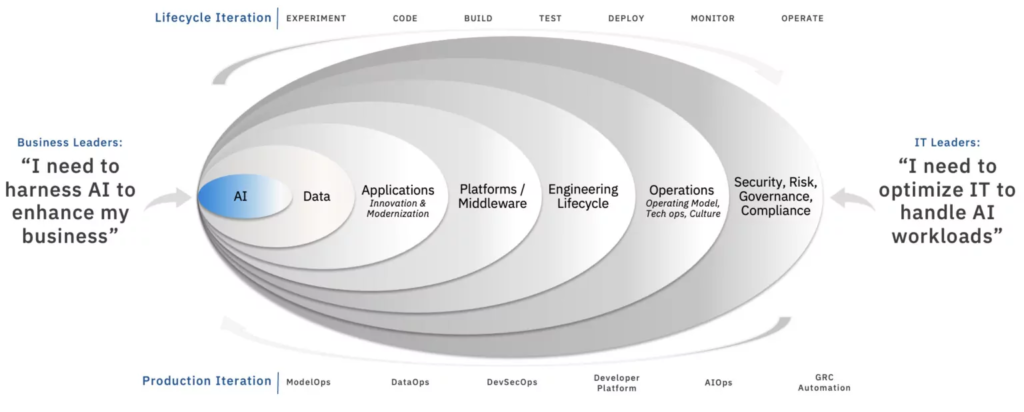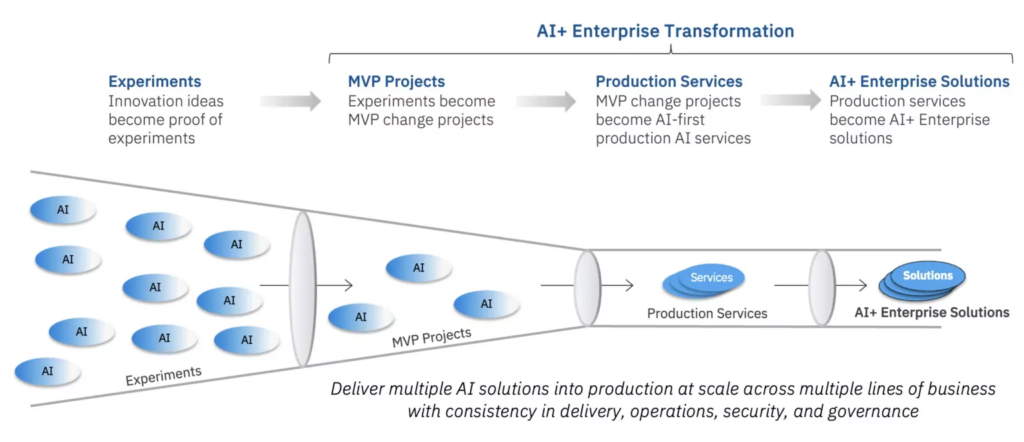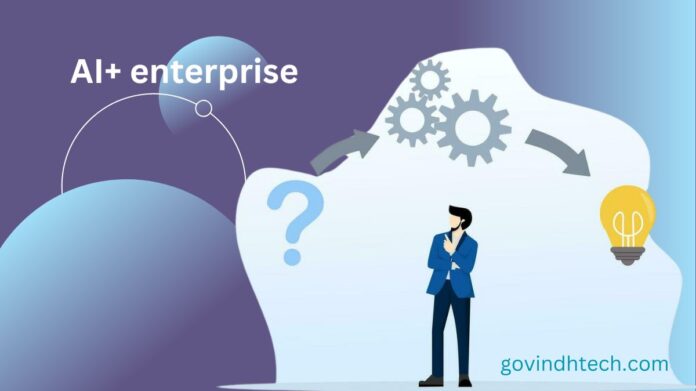IBM AI+ Enterprise
The potential of generative artificial intelligence (AI) to revolutionize all elements of human society and commerce has been seen by IBM and other corporations as they struggle with urgent economic imperatives. Company disruption in 2024 requires businesses to redefine worker productivity to avoid unrealized revenue, protect the software supply chain from threats, and incorporate sustainability into operations to be competitive.
AI is revolutionizing business development. Generative AI (gen AI) transforms company from front to back office, technology modernization, and product and service creation.
Many firms have embraced AI, but to be competitive and expand, they must evolve AI strategy, demonstrate their value, improve risk postures, and incorporate new technical skills. This demands a complete business overhaul. IBM calls this an AI+ enterprise transformation.
Be an AI+ enterprise
An AI+ enterprise innovates with AI as the main emphasis, realizes that AI is vital to the business, and knows that AI affects product innovation, business operations, technical operations, people, and culture.
AI+ enterprise use AI first-class throughout the company. They recognize that if one part of the organization embraces AI while others lag or reject it (due to reasonable concerns), Shadow AI worsens, making it difficult to achieve a holistic plan.
AI+ enterprise benefits
Companies recognize the investment needed to use AI effectively and are demanding a dramatic return on investment (ROI) before investing in an AI use case. Gartner predicts that AI will bring USD 3 to 4 trillion in economic benefits to the global economy across industries.
Clients may obtain ROI for the AI use case and the business and technical skills needed to grow AI use cases by becoming an AI+ enterprise.
An AI+ transformation model embedded into the company fabric and culture may boost ROI by 2.6 times for high-data maturity organizations.
IBM’s AI+ Enterprise Transformation gives customers the business and technical strategies, architectures, roadmaps, and hands-on expertise to become AI+ enterprises.
AI+ enterprise Transformation
IBM’s expertise in AI and hybrid cloud has shown that AI+ enterprises achieve business outcomes quicker. This is exciting since many of their customers are already AI experts, and by implementing AI+ Enterprise Transformation, they find activities that drive company development by running AI in production at scale.

Figure 1 shows how AI+ enterprises must transform many areas throughout the company to increase AI production:
- Use cases that boost company performance
- These application scenarios need responsible AI technology.
- Well-designed data basis for AI efforts
- Application innovation for AI experiences and modernization for AI demands
- Integrating hybrid cloud platform to execute AI, data, and apps as needed
- Building pipelines for app, data, and AI updates, upgrades, and repairs with scanning and guardrails for deployment protection.
- Day-2 operations employing AI to detect and fix mistakes, creating a culture where staff love AI rather than fear replacement.
- Security, governance, risk, and compliance methods are needed to control AI and manage its IT estate, proving regulatory compliance.
Begin with use cases
The most crucial phase for an AI+ enterprise is finding revolutionary use cases. The organization chooses high-value use cases with quicker ROI after testing. It then puts them into production throughout IT, enabling new use cases and innovation.
Figure 2 shows the AI+ use case funnel an AI+ enterprise uses to methodically and rigorously turn use cases into broad-reaching AI enterprise solutions with high ROI, coordinated across delivery, operations, security, and governance.

Use the correct AI
A company using AI+ must choose an AI technology and architecture after determining use cases. Too often, this choice is rushed. It should be approached carefully to guarantee appropriateness.
Provide solid facts
The foundation of AI is data. An AI+ enterprise guarantees that AI data is reliable, transparent, and effective. Otherwise, hazards are too high. They have all seen organisations provide AI with poor data foundations, resulting in bad results. These results usually fall into three undesirable categories:
- Useless: Customers are unimpressed with your outcomes. Stale data, hallucinations, etc.
- Embarrassing: AI data produces offensive output. Example: hatred, abuse, obscenity, bigotry.
- Financial/criminal: Data and AI law violations. Copyright, DORA, data sovereignty, and EU AI legislation are examples.
In an AI+ enterprise, architects can confidently source, prepare, convert, safeguard, and send data to AI locations.
Modernize apps
Innovation with AI-based apps is crucial for great experiences. AI-interacting apps must also be updated. If an AI-powered HR assistant offers to help workers, the application must be able to manage additional traffic. These operations often entail contacting APIs to older programs on architectures unsuitable for AI assistant expectations. Slow reaction times can disappoint.
An AI+ enterprise specializes in creating new AI applications for clients and updating old ones to satisfy AI needs.
A hybrid cloud platform
After understanding AI, data, and apps, the question becomes, “Where do they run this solution?” The solution relies on several elements that vary over time, needing a flexible platform.
An AI+ enterprise may make informed choices without constraining its business by using an open technologies-based hybrid cloud platform.
Continuously improve applications, data, and AI
On a well-designed hybrid cloud platform, AI+ enterprises construct pipelines and toolchains to continually improve and deliver with complete automation. As an example:
- Platform pipelines update infrastructure and software using Terraform and Ansible.
- Application pipelines update code for breakthrough AI-enabled apps and modernized apps used by AI digital workforce.
- For AI to utilize current and valid data, data pipelines process incoming data.
- Data is sent into AI pipelines, which retrain and enhance depending on drift and accuracy.
An AI+ enterprise may improve apps, data, and AI models throughout their lifespan, ensuring only trusted and authorized AI functions go online.
Operations
In an AI-first world, incidents happen. AI+ enterprise employ AI to delight consumers and address IT issues. AI+ enterprises can boost employee productivity with the appropriate tools. Some examples are:
- Finding and fixing application constraints and automating capacity enhancements
- Increasing organizational visibility and information for automation and predictive maintenance
- Preventing security breaches reduces dangers. Use regulation checking of landscape designs to fail delivering if rules are not satisfied.
Along with the right tools, an AI+ enterprise must develop a culture that welcomes AI and educates people. This culture fosters innovation and skill development. AI must be harnessed, evaluated, and accelerated by skilled professionals, not feared.
Secure and manage hybrid cloud AI
Organisations need a safe and controlled environment to scale up AI, especially gen AI. The scope and effect of next-generation AI stress governance and risk management. By securing, monitoring, and explaining AI models and monitoring governance, risk, and compliance rules throughout the hybrid cloud environment, an AI+ enterprise reduces risk.
Pairing existing cloud governance with new AI governance controls requires constant focus to comply with regulatory changes like NIST AI Risk Management Framework, the EU’s Artificial Intelligence Act, ISO/IEC 42001 AI Management, and ISO/IEC 23894 AI Risk Management.


